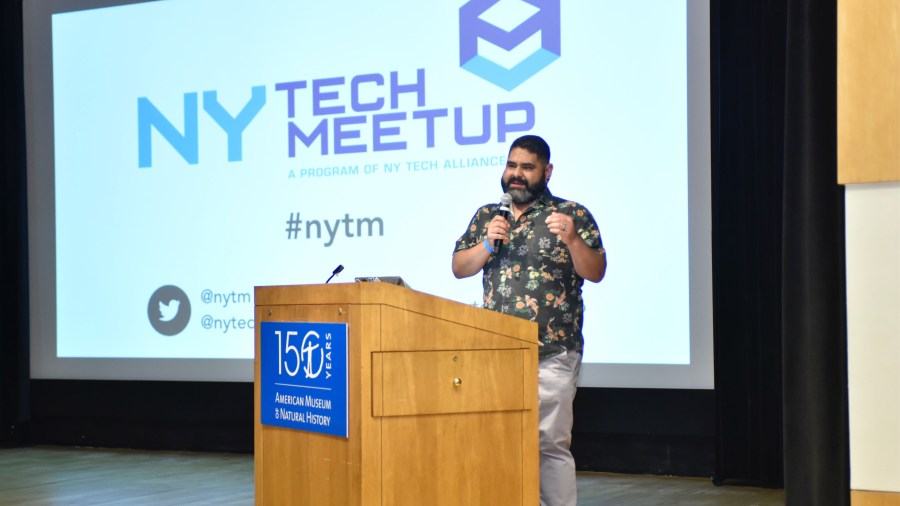How networking can lead to more diversity in tech

There’s been more attention lately on who’s part of the tech boom and who’s not. At Facebook, Google and Apple about three in four technical employees are men — the coders, engineers and developers. African Americans make up a tiny share of that workforce — 1.5% at Facebook, 2.8% at Google and 6% at Apple, according to data reported by the companies themselves.
One place many companies look for new talent is tech meetups, casual networking events where people go to hear updates on industry trends and connect with collaborators. Those meetups can look similar to the tech world itself — skewing white and male. That’s what Andy Saldaña found when he attended his first such event. Saldaña went on to become executive director of the nonprofit, New York Tech Alliance.
In the latest installment of Evenly Distributed, Saldaña talks about his experience as a gay man of color in tech, and how he aims to change the scene. The following is an edited transcript of his story in his own words.

I went to a New York tech meetup before I was hired to see what the event was all about, and I felt very out of place. I was one of the very few brown people in the room. That is really what has driven a lot of our work and my work specifically, to make that community more representative of New York as a whole.
I’m a gay man in New York City, so my network is very full of other gay men in New York City. And I’m very conscious of that when I’m looking to potentially hire additional people. I must make the effort to make sure that I’m reaching out to the networks that represent other types of diversity. It’s not the easiest thing for a nonprofit leader to do, because you are operating on both low budget and a time constraint. So, you’re trying to make all this fit as quickly as possible and as cheaply as possible.
I don’t think that there’s going to be a magic level that we hit of equity among everybody. There’s always going to be somebody who’s underrepresented. I think the conversation that we’re having now is getting us to a point where we are understanding the concepts and the thinking behind it, of what it means. What does inclusivity mean? What does diversity really mean? Can you have it without equity? What does equity mean? I think that we’re asking these questions right now.
I don’t know that we’re going to reach this level of everybody at the table is bringing X amount of diversity to the table, and this product has been a product of this percentage of diverse input. I don’t think that’s the right way to look at it. I think that the conversation will always continue to evolve. I don’t think I can go a day without having a conversation around diversity and inclusion in technology. I think that that’s a good step forward. I don’t think we’re anywhere near where we need to be. There’s still a lot of work that needs to happen. Talking about these issues is not going to solve them. Now it’s like, what do we need to do? What are the next steps? How do we really start thinking in this way?

Related links: more insight from Amy Scott
Networking is hard. And if the whole idea of going to one of these meetups makes you want to crawl into bed, check out the “Introvert’s guide to networking at tech meetups” on Noteworthy. One tip: practice talking to strangers on the street. Dog owners are a good bet, according to the author, because you can start out talking to the dog.
And there’s a lot more to those diversity reports from the tech giants, digging into not just gender, race and ethnicity, but also categories like military service, disability, sexual orientation and gender identity.
TechCrunch had a long read a couple months back looking at the future of diversity and inclusion efforts, and how much progress has been made since activists started pushing companies to report these numbers. Spoiler alert: not enough.
Meanwhile, a new book offers a guide to understanding and confronting racism in our society and in ourselves. “How to be an Antiracist” by Ibram X. Kendi is part how-to book, part memoir. Kendi is a black scholar who comes to terms in the book with his own past racist ideas and pushes readers to see racism as a cancer that has to be actively treated to be cured.
There’s a New Yorker’s review and a six-step primer based on the book from Mashable.
The future of this podcast starts with you.
Every day, the “Marketplace Tech” team demystifies the digital economy with stories that explore more than just Big Tech. We’re committed to covering topics that matter to you and the world around us, diving deep into how technology intersects with climate change, inequity, and disinformation.
As part of a nonprofit newsroom, we’re counting on listeners like you to keep this public service paywall-free and available to all.
Support “Marketplace Tech” in any amount today and become a partner in our mission.

















